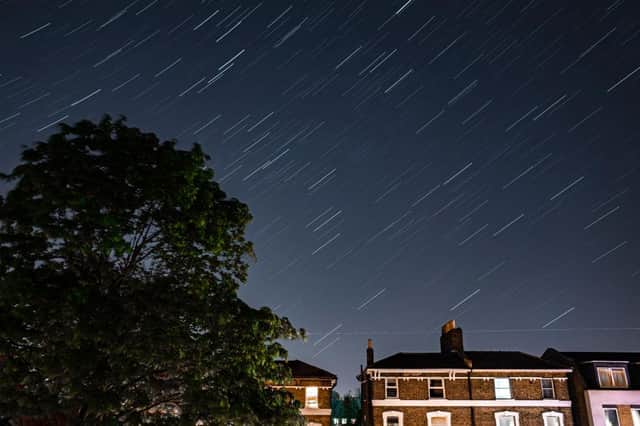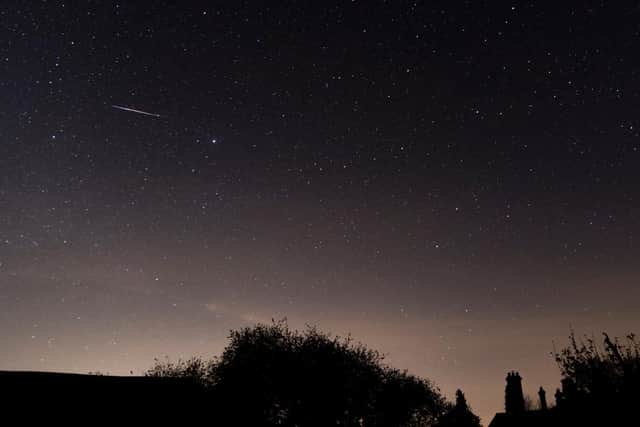Lyrid meteor shower 2021: what is it, how to see shooting stars in the UK tonight – and when is the peak?


Skygazers can look forward to catching the Lyrid meteor shower on Thursday (22 April) morning, with up to 18 meteors per hour expected to light up the dawn skies.
Meteor showers, or shooting stars, are caused when pieces of debris, known as meteorites, enter Earth’s atmosphere at speeds of around 43 miles per second, burning up and causing streaks of light.
Here is everything you need to know about it.


What are the Lyrids?
Advertisement
Hide AdAdvertisement
Hide AdThe Lyrids are one of the oldest known meteor showers, with records dating back 2,700 years. The ancient Chinese are said to have watched Lyrid meteors falling "like rain" in the year 687 BC.
The Lyrids are caused by the interaction of the Earth’s atmosphere with the dust trail left by the Comet C/1861 G1 Thatcher; when particles of debris enter the Earth’s atmosphere, they burn up, producing a trail of light across the sky.
Comet C/1861 G1 Thatcher only orbits the sun every 415 years, but occasionally, specific planetary arrangements can steer the dust trail into Earth’s path, intensifying the shower.
This happens roughly every 60 years, and while it won't be the case in 2021, observers could still be treated to some ‘Lyrid fireballs’ - brighter meteors that can even cast shadows for a split second and leave behind a trail of glowing ionized gas.
Advertisement
Hide AdAdvertisement
Hide AdThe comet is expected to return to the inner solar system in 2276.
When is the best time to see the shower?
The Lyrid meteor shower takes place between 16 and 25 April, but will peak and be at its most dramatic on 22 April.
The celestial display is expected to peak at 1pm UK time, but Obviously, it will be bright daylight at that time, and the shooting stars will not be visible in the midday sun.
Astronomers say the best time to see it in the UK will be early in the morning, or just after sunset.
Advertisement
Hide AdAdvertisement
Hide AdTania de Sales Marques, an astronomer at the Royal Observatory Greenwich, told the PA news agency: “Since the peak occurs during the day the best time to try to spot the shower will be before sunrise on the 22nd or after sunset.
“It is expected that this meteor shower will produce around 18 meteors per hour.”
What do I need to see the shower?
The Lyrids should be visible with the naked eye, depending on a couple of factors.
Weather plays a big part, and with April skies often clouded over, spotting the meteors might be easier said than done, and those living in an area with minimal light pollution will have increased chances of spotting a fireball.
Advertisement
Hide AdAdvertisement
Hide AdThose living in built-up areas are advised to travel to less populated spaces if they really want to see the shower. But as the coronavirus pandemic rolls on, be mindful of social distancing measures and lockdown restrictions that may remain in place in your area.
If you're able to venture out into your garden to spot the show, wrapping up in warm clothes is recommended, and you should allow up to 15-20 minutes for your eyes to fully adjust to the night sky.
The Moon will be at a waxing gibbous phase, meaning that it will be quite bright in the sky, “so conditions won’t be very favourable,” says de Sales Marques.
Where should I look in the sky?
The Lyrids are so called because they appear to radiate from the constellation of Lyra the Harp, and those waiting to catch a glimpse of the meteors will also be able to spot Vega, which is Lyra’s brightest star.
Advertisement
Hide AdAdvertisement
Hide Adde Sales Marques told PA: “Vega is one of the brightest stars in the sky and one of three stars that make up the Summer Triangle.
“This recognisable asterism will be easy to find in the predawn sky.”
However, looking directly at it may cause you to miss the more spectacular meteors, and Lyrids can actually show up in any part of the sky.
“It is worth mentioning that meteors will be visible all over the sky," added de Sales Marques, “not just in the direction of the radiant, so to maximise your chance of spotting meteors, try to find a safe place that has an unobstructed view of the whole sky.”
How ‘spectacular’ will it be?
Advertisement
Hide AdAdvertisement
Hide AdRelative to other meteor showers on the astronomical calendar, the Lyrids are one of the less dramatic displays, but they can still offer up an average of 20 meteors per hour.
That’s nothing compared to the shower of 1803, which delivered 700 meteors an hour. That’s about one every five seconds, and the shower has been known to have dramatic outbursts.
No such outburst is predicted for 2021, but it is a hard thing to pinpoint, so you never know.